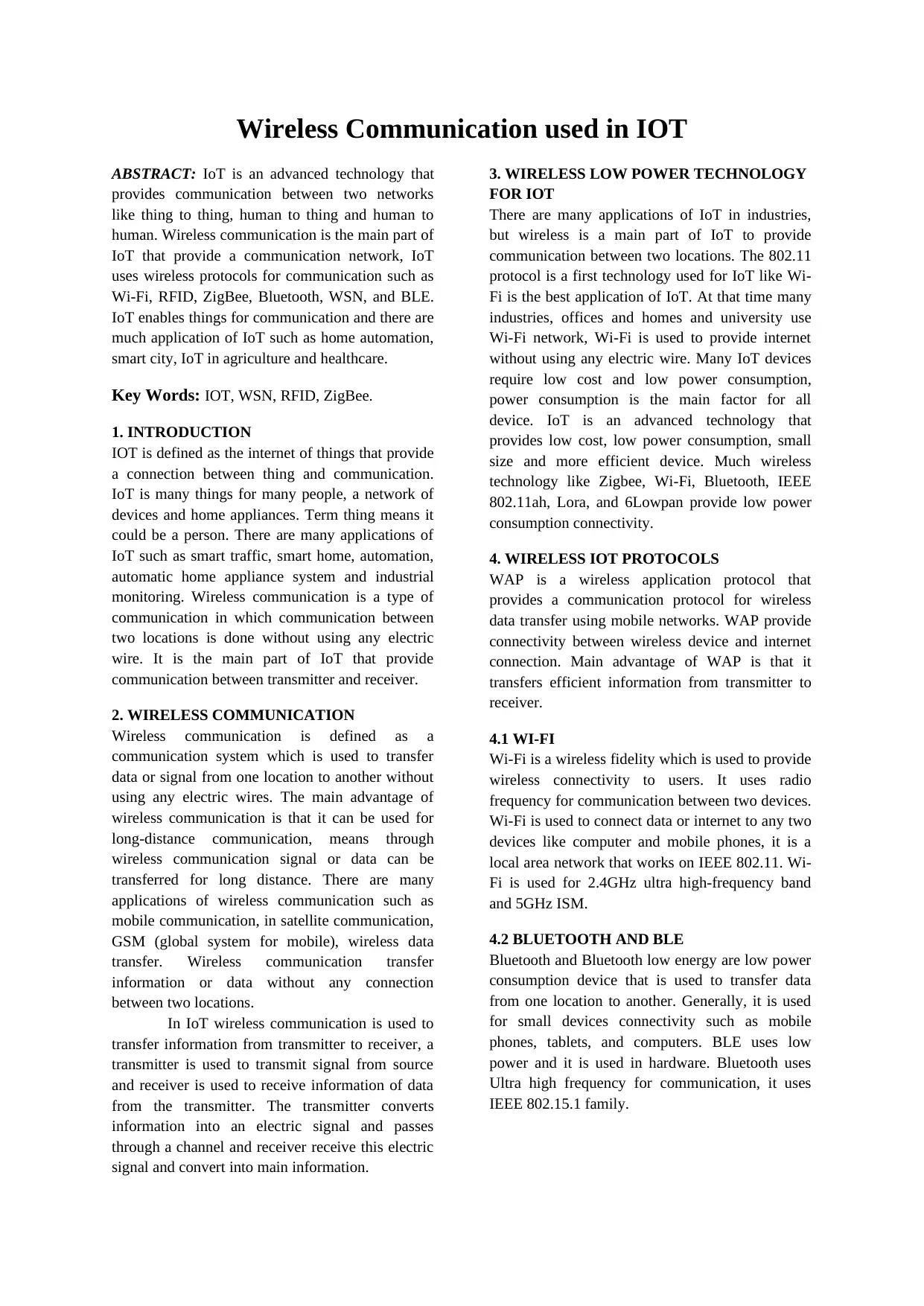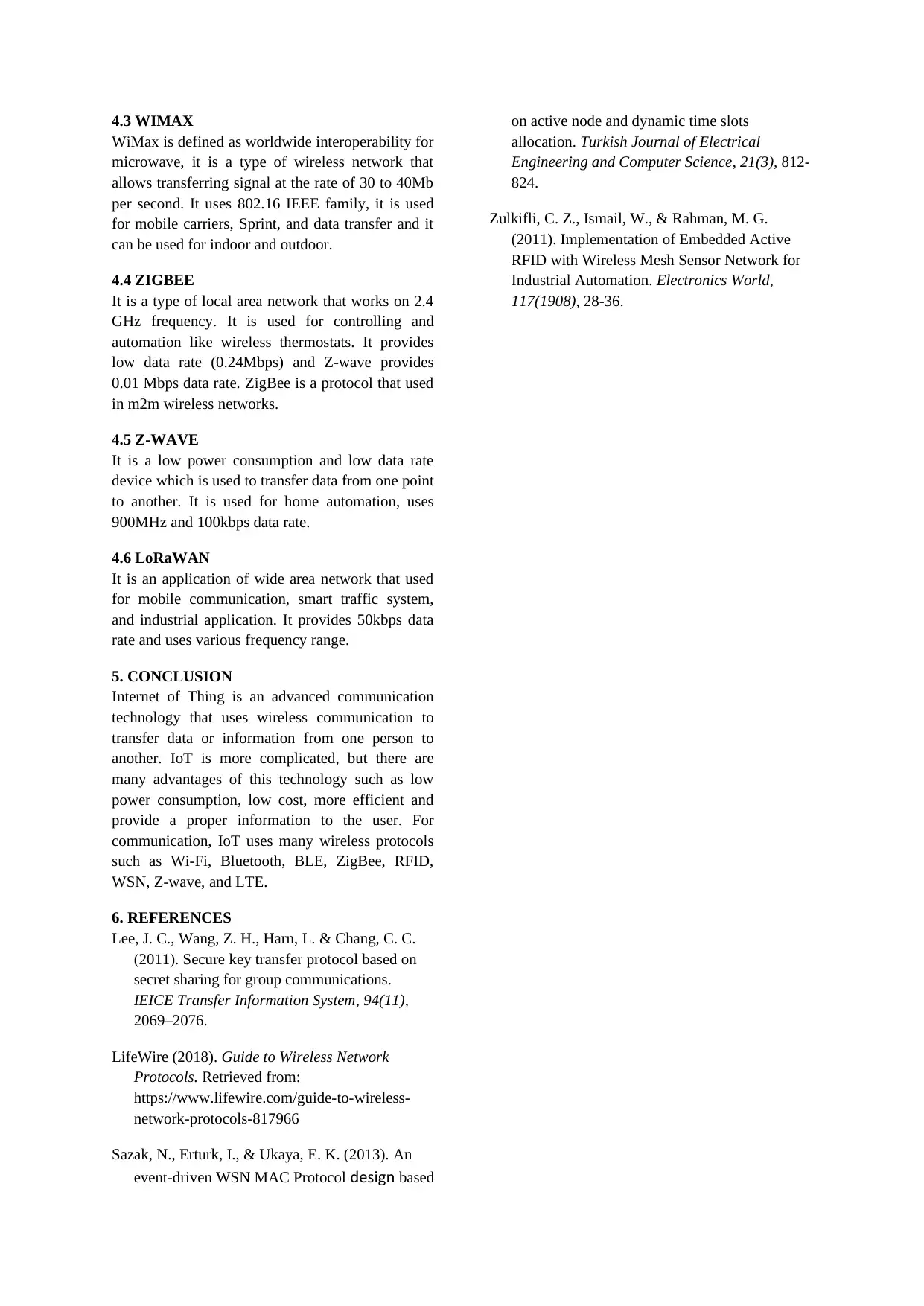Wireless Communication used in IOT - IEEE Format
VerifiedAdded on 2023/06/10
|3
|1146
|390
AI Summary
This article discusses the importance of wireless communication in IoT and the various protocols used such as Wi-Fi, ZigBee, and Bluetooth. It also covers low power technology for IoT and wireless IoT protocols. The article is written in IEEE format.
Contribute Materials
Your contribution can guide someone’s learning journey. Share your
documents today.

Running Head: WIRELESS COMMUNICATION 0
Wireless Communication in IOT
IEEE Format
Wireless Communication in IOT
IEEE Format
Secure Best Marks with AI Grader
Need help grading? Try our AI Grader for instant feedback on your assignments.

Wireless Communication used in IOT
ABSTRACT: IoT is an advanced technology that
provides communication between two networks
like thing to thing, human to thing and human to
human. Wireless communication is the main part of
IoT that provide a communication network, IoT
uses wireless protocols for communication such as
Wi-Fi, RFID, ZigBee, Bluetooth, WSN, and BLE.
IoT enables things for communication and there are
much application of IoT such as home automation,
smart city, IoT in agriculture and healthcare.
Key Words: IOT, WSN, RFID, ZigBee.
1. INTRODUCTION
IOT is defined as the internet of things that provide
a connection between thing and communication.
IoT is many things for many people, a network of
devices and home appliances. Term thing means it
could be a person. There are many applications of
IoT such as smart traffic, smart home, automation,
automatic home appliance system and industrial
monitoring. Wireless communication is a type of
communication in which communication between
two locations is done without using any electric
wire. It is the main part of IoT that provide
communication between transmitter and receiver.
2. WIRELESS COMMUNICATION
Wireless communication is defined as a
communication system which is used to transfer
data or signal from one location to another without
using any electric wires. The main advantage of
wireless communication is that it can be used for
long-distance communication, means through
wireless communication signal or data can be
transferred for long distance. There are many
applications of wireless communication such as
mobile communication, in satellite communication,
GSM (global system for mobile), wireless data
transfer. Wireless communication transfer
information or data without any connection
between two locations.
In IoT wireless communication is used to
transfer information from transmitter to receiver, a
transmitter is used to transmit signal from source
and receiver is used to receive information of data
from the transmitter. The transmitter converts
information into an electric signal and passes
through a channel and receiver receive this electric
signal and convert into main information.
3. WIRELESS LOW POWER TECHNOLOGY
FOR IOT
There are many applications of IoT in industries,
but wireless is a main part of IoT to provide
communication between two locations. The 802.11
protocol is a first technology used for IoT like Wi-
Fi is the best application of IoT. At that time many
industries, offices and homes and university use
Wi-Fi network, Wi-Fi is used to provide internet
without using any electric wire. Many IoT devices
require low cost and low power consumption,
power consumption is the main factor for all
device. IoT is an advanced technology that
provides low cost, low power consumption, small
size and more efficient device. Much wireless
technology like Zigbee, Wi-Fi, Bluetooth, IEEE
802.11ah, Lora, and 6Lowpan provide low power
consumption connectivity.
4. WIRELESS IOT PROTOCOLS
WAP is a wireless application protocol that
provides a communication protocol for wireless
data transfer using mobile networks. WAP provide
connectivity between wireless device and internet
connection. Main advantage of WAP is that it
transfers efficient information from transmitter to
receiver.
4.1 WI-FI
Wi-Fi is a wireless fidelity which is used to provide
wireless connectivity to users. It uses radio
frequency for communication between two devices.
Wi-Fi is used to connect data or internet to any two
devices like computer and mobile phones, it is a
local area network that works on IEEE 802.11. Wi-
Fi is used for 2.4GHz ultra high-frequency band
and 5GHz ISM.
4.2 BLUETOOTH AND BLE
Bluetooth and Bluetooth low energy are low power
consumption device that is used to transfer data
from one location to another. Generally, it is used
for small devices connectivity such as mobile
phones, tablets, and computers. BLE uses low
power and it is used in hardware. Bluetooth uses
Ultra high frequency for communication, it uses
IEEE 802.15.1 family.
ABSTRACT: IoT is an advanced technology that
provides communication between two networks
like thing to thing, human to thing and human to
human. Wireless communication is the main part of
IoT that provide a communication network, IoT
uses wireless protocols for communication such as
Wi-Fi, RFID, ZigBee, Bluetooth, WSN, and BLE.
IoT enables things for communication and there are
much application of IoT such as home automation,
smart city, IoT in agriculture and healthcare.
Key Words: IOT, WSN, RFID, ZigBee.
1. INTRODUCTION
IOT is defined as the internet of things that provide
a connection between thing and communication.
IoT is many things for many people, a network of
devices and home appliances. Term thing means it
could be a person. There are many applications of
IoT such as smart traffic, smart home, automation,
automatic home appliance system and industrial
monitoring. Wireless communication is a type of
communication in which communication between
two locations is done without using any electric
wire. It is the main part of IoT that provide
communication between transmitter and receiver.
2. WIRELESS COMMUNICATION
Wireless communication is defined as a
communication system which is used to transfer
data or signal from one location to another without
using any electric wires. The main advantage of
wireless communication is that it can be used for
long-distance communication, means through
wireless communication signal or data can be
transferred for long distance. There are many
applications of wireless communication such as
mobile communication, in satellite communication,
GSM (global system for mobile), wireless data
transfer. Wireless communication transfer
information or data without any connection
between two locations.
In IoT wireless communication is used to
transfer information from transmitter to receiver, a
transmitter is used to transmit signal from source
and receiver is used to receive information of data
from the transmitter. The transmitter converts
information into an electric signal and passes
through a channel and receiver receive this electric
signal and convert into main information.
3. WIRELESS LOW POWER TECHNOLOGY
FOR IOT
There are many applications of IoT in industries,
but wireless is a main part of IoT to provide
communication between two locations. The 802.11
protocol is a first technology used for IoT like Wi-
Fi is the best application of IoT. At that time many
industries, offices and homes and university use
Wi-Fi network, Wi-Fi is used to provide internet
without using any electric wire. Many IoT devices
require low cost and low power consumption,
power consumption is the main factor for all
device. IoT is an advanced technology that
provides low cost, low power consumption, small
size and more efficient device. Much wireless
technology like Zigbee, Wi-Fi, Bluetooth, IEEE
802.11ah, Lora, and 6Lowpan provide low power
consumption connectivity.
4. WIRELESS IOT PROTOCOLS
WAP is a wireless application protocol that
provides a communication protocol for wireless
data transfer using mobile networks. WAP provide
connectivity between wireless device and internet
connection. Main advantage of WAP is that it
transfers efficient information from transmitter to
receiver.
4.1 WI-FI
Wi-Fi is a wireless fidelity which is used to provide
wireless connectivity to users. It uses radio
frequency for communication between two devices.
Wi-Fi is used to connect data or internet to any two
devices like computer and mobile phones, it is a
local area network that works on IEEE 802.11. Wi-
Fi is used for 2.4GHz ultra high-frequency band
and 5GHz ISM.
4.2 BLUETOOTH AND BLE
Bluetooth and Bluetooth low energy are low power
consumption device that is used to transfer data
from one location to another. Generally, it is used
for small devices connectivity such as mobile
phones, tablets, and computers. BLE uses low
power and it is used in hardware. Bluetooth uses
Ultra high frequency for communication, it uses
IEEE 802.15.1 family.

4.3 WIMAX
WiMax is defined as worldwide interoperability for
microwave, it is a type of wireless network that
allows transferring signal at the rate of 30 to 40Mb
per second. It uses 802.16 IEEE family, it is used
for mobile carriers, Sprint, and data transfer and it
can be used for indoor and outdoor.
4.4 ZIGBEE
It is a type of local area network that works on 2.4
GHz frequency. It is used for controlling and
automation like wireless thermostats. It provides
low data rate (0.24Mbps) and Z-wave provides
0.01 Mbps data rate. ZigBee is a protocol that used
in m2m wireless networks.
4.5 Z-WAVE
It is a low power consumption and low data rate
device which is used to transfer data from one point
to another. It is used for home automation, uses
900MHz and 100kbps data rate.
4.6 LoRaWAN
It is an application of wide area network that used
for mobile communication, smart traffic system,
and industrial application. It provides 50kbps data
rate and uses various frequency range.
5. CONCLUSION
Internet of Thing is an advanced communication
technology that uses wireless communication to
transfer data or information from one person to
another. IoT is more complicated, but there are
many advantages of this technology such as low
power consumption, low cost, more efficient and
provide a proper information to the user. For
communication, IoT uses many wireless protocols
such as Wi-Fi, Bluetooth, BLE, ZigBee, RFID,
WSN, Z-wave, and LTE.
6. REFERENCES
Lee, J. C., Wang, Z. H., Harn, L. & Chang, C. C.
(2011). Secure key transfer protocol based on
secret sharing for group communications.
IEICE Transfer Information System, 94(11),
2069–2076.
LifeWire (2018). Guide to Wireless Network
Protocols. Retrieved from:
https://www.lifewire.com/guide-to-wireless-
network-protocols-817966
Sazak, N., Erturk, I., & Ukaya, E. K. (2013). An
event-driven WSN MAC Protocol design based
on active node and dynamic time slots
allocation. Turkish Journal of Electrical
Engineering and Computer Science, 21(3), 812-
824.
Zulkifli, C. Z., Ismail, W., & Rahman, M. G.
(2011). Implementation of Embedded Active
RFID with Wireless Mesh Sensor Network for
Industrial Automation. Electronics World,
117(1908), 28-36.
WiMax is defined as worldwide interoperability for
microwave, it is a type of wireless network that
allows transferring signal at the rate of 30 to 40Mb
per second. It uses 802.16 IEEE family, it is used
for mobile carriers, Sprint, and data transfer and it
can be used for indoor and outdoor.
4.4 ZIGBEE
It is a type of local area network that works on 2.4
GHz frequency. It is used for controlling and
automation like wireless thermostats. It provides
low data rate (0.24Mbps) and Z-wave provides
0.01 Mbps data rate. ZigBee is a protocol that used
in m2m wireless networks.
4.5 Z-WAVE
It is a low power consumption and low data rate
device which is used to transfer data from one point
to another. It is used for home automation, uses
900MHz and 100kbps data rate.
4.6 LoRaWAN
It is an application of wide area network that used
for mobile communication, smart traffic system,
and industrial application. It provides 50kbps data
rate and uses various frequency range.
5. CONCLUSION
Internet of Thing is an advanced communication
technology that uses wireless communication to
transfer data or information from one person to
another. IoT is more complicated, but there are
many advantages of this technology such as low
power consumption, low cost, more efficient and
provide a proper information to the user. For
communication, IoT uses many wireless protocols
such as Wi-Fi, Bluetooth, BLE, ZigBee, RFID,
WSN, Z-wave, and LTE.
6. REFERENCES
Lee, J. C., Wang, Z. H., Harn, L. & Chang, C. C.
(2011). Secure key transfer protocol based on
secret sharing for group communications.
IEICE Transfer Information System, 94(11),
2069–2076.
LifeWire (2018). Guide to Wireless Network
Protocols. Retrieved from:
https://www.lifewire.com/guide-to-wireless-
network-protocols-817966
Sazak, N., Erturk, I., & Ukaya, E. K. (2013). An
event-driven WSN MAC Protocol design based
on active node and dynamic time slots
allocation. Turkish Journal of Electrical
Engineering and Computer Science, 21(3), 812-
824.
Zulkifli, C. Z., Ismail, W., & Rahman, M. G.
(2011). Implementation of Embedded Active
RFID with Wireless Mesh Sensor Network for
Industrial Automation. Electronics World,
117(1908), 28-36.
1 out of 3
Related Documents
Your All-in-One AI-Powered Toolkit for Academic Success.
+13062052269
info@desklib.com
Available 24*7 on WhatsApp / Email
![[object Object]](/_next/static/media/star-bottom.7253800d.svg)
Unlock your academic potential
© 2024 | Zucol Services PVT LTD | All rights reserved.



